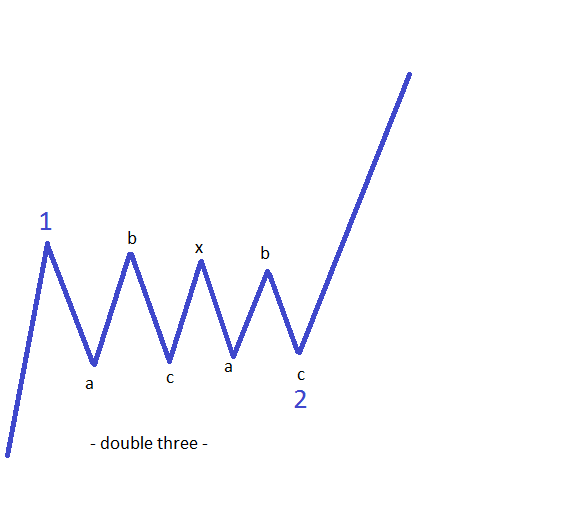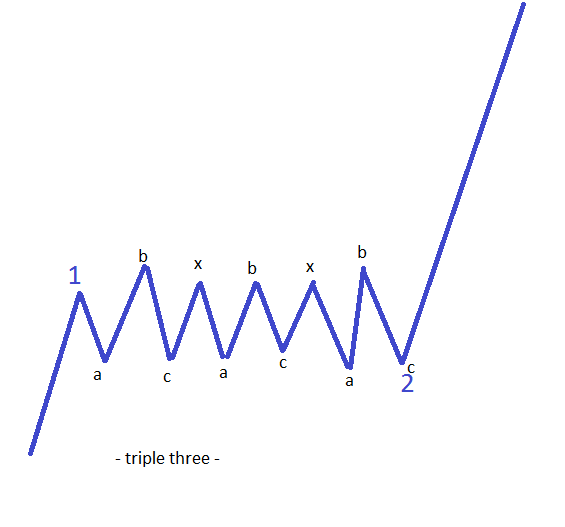The Difference between Double and Triple Threes in Trading with Elliott
One of the last types of complex correction presented here on our Forex Trading Academy project is the double and triple three patterns. These patterns are considered to be rare ones, but they do form on the Forex market. Of the places where they may appear, they have a predilection to form as second waves in impulsive moves, and not that often, as b-waves in zigzags. Regardless of whether it is a second or a b-wave, the move to follow should be a powerful one. As a rule of thumb, the longer the double- or triple-three pattern takes to form, the more aggressive move to follow next will be. What makes a double- and a triple-three pattern, and how are they different from the other patterns discovered by Elliott?
| Broker | Bonus | More |
|---|
Defining a Double and Triple Three Pattern
Both these patterns fall into the category of complex corrections with a large x-wave. So far we’ve only treated the running corrections as corrections in this category, and this article serves to complement those dedicated to running corrections. A large x-wave means that the intervening wave will retrace more than 61.8% into the territory of the previous correction. This retracement level should be considered as the minimum one, in the sense that the x-wave can go and easily reverse the whole previous correction, without the overall pattern falling into the running correction category.
Spotting a Double Three Pattern

This represents just a small trick for trading the Forex market in general. To complicate things even further, there is the possibility that, instead of the second flat pattern in the double three, the market is forming a triangle. This would make the overall pattern even more time-consuming, as the triangle has five segments, and all of them are corrective ones as well.
What Makes a Triple-Three Pattern?

As mentioned earlier, the more the pattern consolidates, the more powerful the move that follows is going to be. Therefore, both double and triple threes form as the second wave in an impulsive move, as the third wave, in this case, will be the one that is extended. A triple-three pattern can end with a triangle as well, and this is the most complex pattern that can form on the horizontal. It implies that the first two corrective waves are flat patterns, the two x-waves retrace more than 61.8% of the previous flat, and the last segment is a triangle.
To complicate things even further, imagine that the triangle has another triangle, of a lower degree, for the e-wave. This will result in the overall pattern having no less than 17(!) segments: six segments corresponding to the first two flat patterns, two segments for the two x-waves, four segments for the first four waves in the triangle, and five segments as the e-wave of the triangle. A proper labelling of a triple three that ends with a triangle should look like this: abc–x–abc–x–abcde. The last e-wave should be a triangle in its own right, of a lower degree, which should be labelled a–b–c–d–e. The third wave that follows such a pattern should be even bigger than the one that follows a double three pattern, and should travel far beyond the 161.8% extension needed in an impulsive structure.The same thing is valid for the fifth wave, in the event that the double and triple three is the b-wave of a zigzag. In this instance, the most likely case is that the zigzag would be an elongated pattern, due to the size of the c-wave.
With these two patterns, complex corrections with Elliott Waves theory are covered completely, and the only thing we still need to do is to take a closer look at the types of impulsive waves Elliott discovered. It is only normal to come back to where the whole theory started: a five-wave structure, corrected with a three-wave one.
Other educational materials
- How to Use Parabolic SAR to Buy Dips or Sell Spikes
- Bollinger Bands – Profit from One of the Best Trend Indicators
- Trading with the Cloud – Use Ichimoku Cloud to Spot Reversals
- Forex Market Terminology
- Profit from Forex Trading Using Different Trading Styles
- How to Set Up an Expert Advisor
Recommended further readings
- Theoretical notes on trade problems. Samuelson, P.A., 1964. The Review of Economics and Statistics, pp.145-154.
- Financing alternative development through double bottom line private equity funds & a real estate social investment framework Levy, J. E. (2005). (Doctoral dissertation, Massachusetts Institute of Technology).


